Sam Bescoby is an Equine Dental Vet and looks after our horses and ponies’ teeth at our Glenda Spooner Farm Rescue and Rehoming Centre. Sam has kindly explained what is involved with routine dental care as well as common problems that can occur with horses’ teeth.
A horse’s teeth have to work hard to break down grass and hay to around 3mm before it enters the stomach, which means the teeth wear continually. They have adapted to this high attrition by having a large reserve of tooth below the gum line which constantly erupts (grows) over the life of the horse.
The combination of domestication and the land we keep our horses on means that their teeth often don’t wear down evenly. Good quality pasture results in horses not having to graze for as long nor work as hard when chewing. On top of this, the act of riding horses’ places pressure points in and around the mouth which can exacerbate problems unless the horse’s teeth are regularly checked.
Who should look at my horse’s teeth?
Legally anyone can look at and manually rasp the teeth of horses in the UK. However, it is a very specialised skill – untrained practitioners can do a lot of damage and will often miss the early signs of problems developing. Fortunately, there are professionals who have undertaken training, passed rigorous examinations and attend regular training courses after qualifying. We advise you use one of the following suitably qualified professionals:
- Veterinary Surgeons: Many equine vets carry out a large amount of dentistry as part of their normal workday. There are now veterinary surgeons who are recognised by their Royal College as either ‘advanced’ or ‘specialist’ in the field of equine dentistry. These vets will see a higher caseload of dental issues and undertake more complex procedures involving the teeth and sinuses of your horse.
- Qualified Equine Dental Technicians: Two groups of Equine Dental Technicians are currently recognised by vets and other equine governing bodies. These are the British Association of Equine Dental Technicians (BAEDT) and The WorldWide Association of Equine Dentistry (WWAED). Both groups require dental technicians to undertake specific training and examinations in order to join the associations. Their members are allowed to perform a greater range of procedures in your horse’s mouth than non-qualified dental technicians, including using motorised equipment. Lists of members can be found on their websites:
www.baedt.com
www.wwaed.org.uk
What should happen during my horse’s routine dental examination?
We advise that routine dental examinations are carried out every six months for horses under the age of eight and over the age of eighteen. If there are no causes for concern picked up at a previous exam, then horses aged between the ages of eight and eighteen can be checked every twelve months.
The following process is what you should expect when an Equine Dental Technician or veterinary surgeon visits your horse(s) for a routine dental check.
- Detailed examination of the head looking for evidence of muscle wastage, nasal discharge and other signs of possible dental disease. At this stage a thorough history is usually taken including questions about ridden comfort, diet and any signs of dental disease such as dropping food (quidding) or bad breath (halitosis).
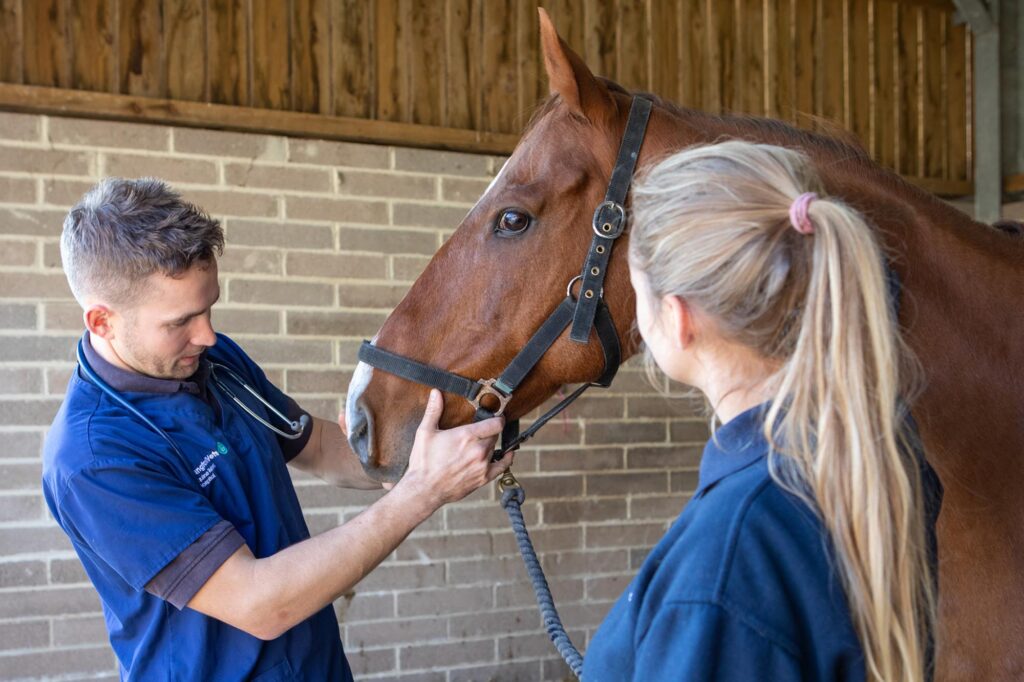
- Sedation: A detailed examination is key to modern equine dentistry. You cannot treat what you cannot see. Many horses require a light dose of sedation to allow for a full oral exam. Whilst your horse may tolerate a rasp unsedated, many small areas of disease could be missed when trying to look carefully in their mouth. It is easy to treat most dental disease in its early stages and often only becomes invasive should we miss these subtle signs.
- Oral exam:
a) First the incisors are checked. These teeth are primarily used for grazing and disease here can lead to a horse not feeding properly when out at pasture or when fed from a small holed hay net. At this stage we also palpate for any pain within the front part of the mouth which may lead to discomfort when the bit is placed.
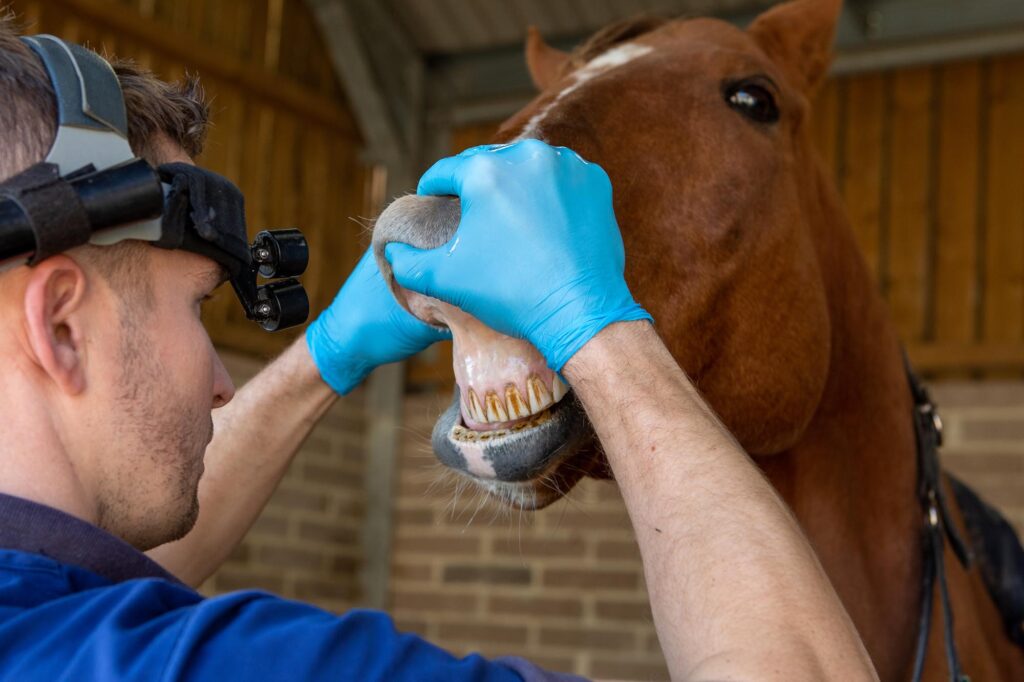
b) A speculum is then placed to hold the jaw open and the mouth washed.
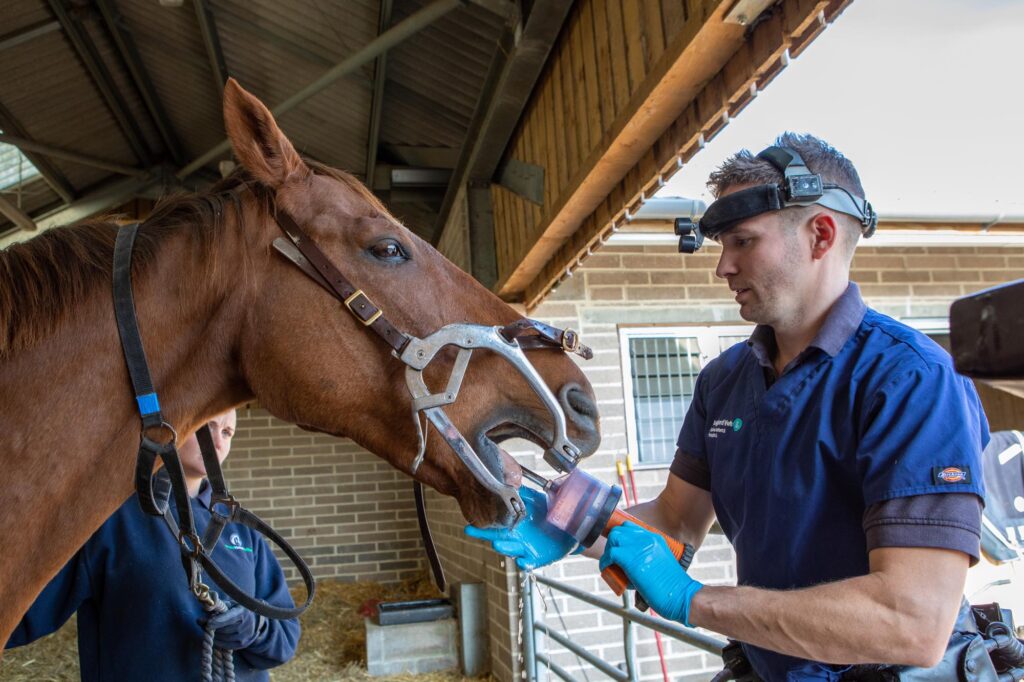
c) Every tooth is palpated to detect for sharp points, mobile and missing teeth.
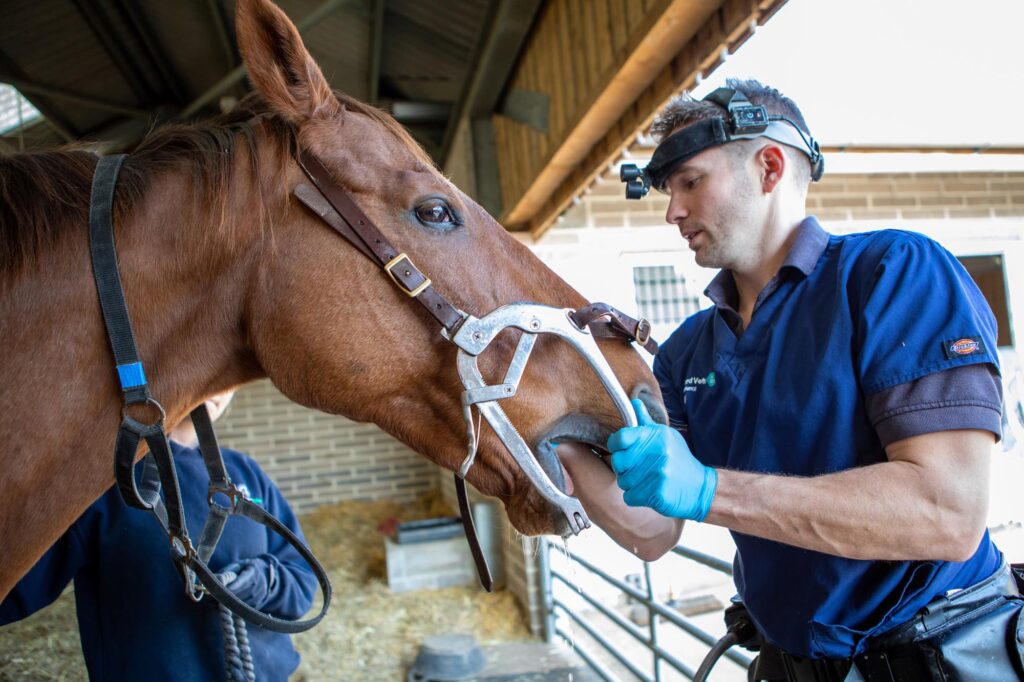
d) The inside of the mouth is then checked using a bright headtorch and a mirror. Any areas of concern are then explored with purpose built equine dental probes.
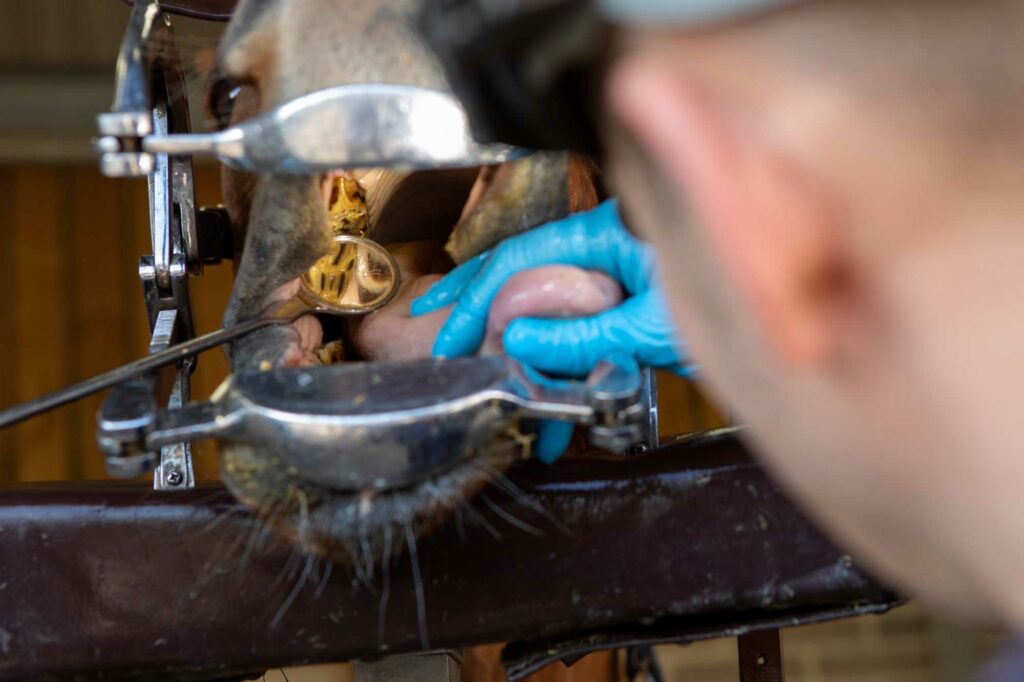
- A treatment plan can now be made and carried out. Most professionals are now using motorised dental rasps. The new models are quiet, very safe in competent hands and allow precise reductions of any overgrowths or areas or sharpness. Light sedation and a headstand allow the operator to carefully view the rasp and ensure only the areas of concern are addressed.
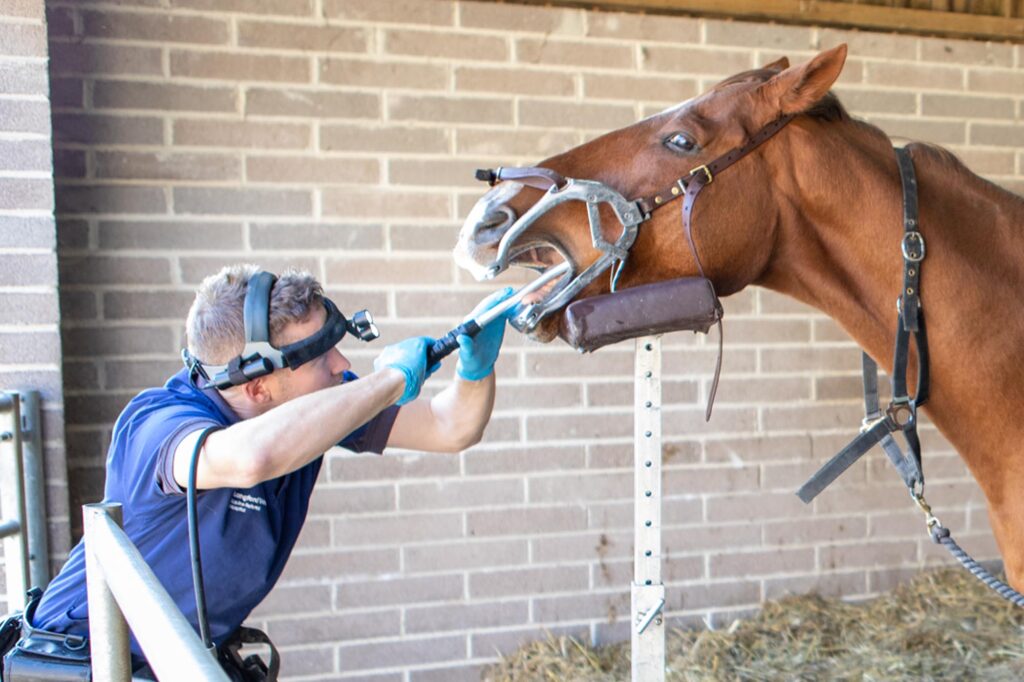
- A final rinse takes place and the speculum is removed.
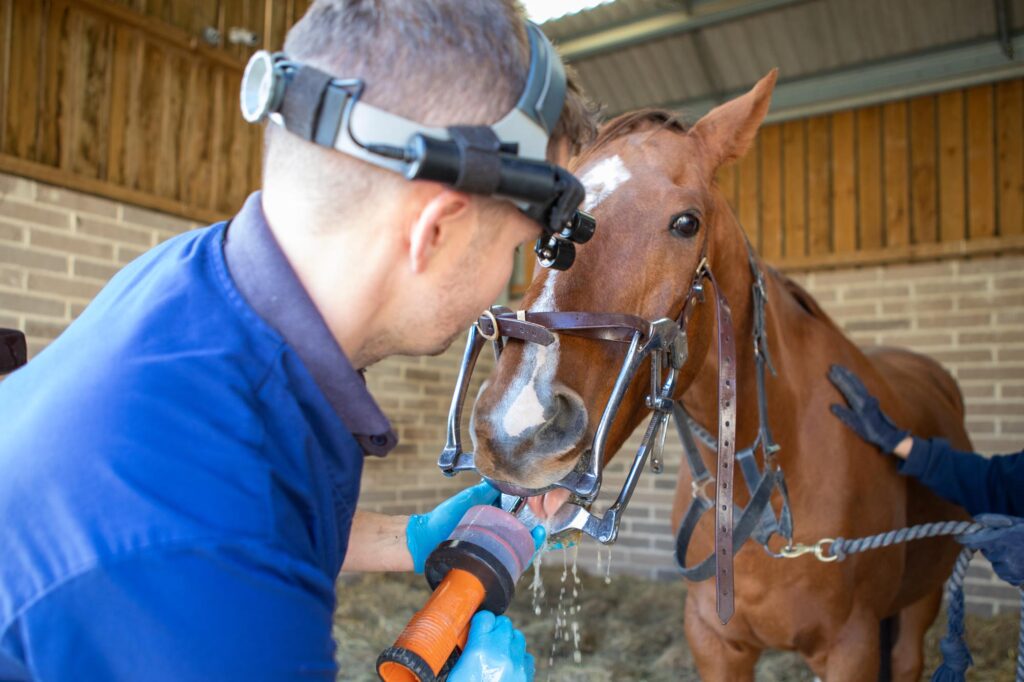
- A chart is completed noting what was found and how it was treated. This can then be used when revisiting next time or should your horse need further treatment elsewhere.
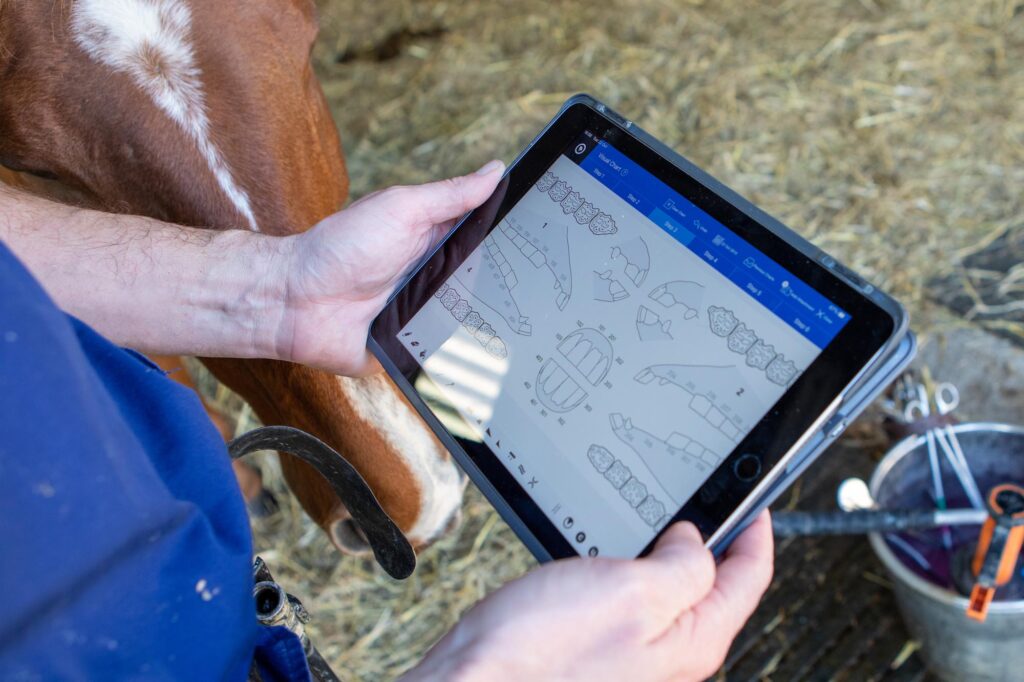
What are the signs of dental problems in horses?
There are a number of common problems found in horses’ mouths and horses with dental pain may show some of the following signs:
- Quidding – chewed food is either dropped or spat back out
- Weight loss
- Halitosis – bad breath
- Reluctance to be touched around the head area
- Swellings of the jaw or face
- Nasal discharge – this is often yellow coloured and on one side only
However, it’s very common for horses to show no outward signs of dental pain at all, even with major problems. This is why regular routine examinations are essential.
What are the most common dental problems in horses?
Equine teeth continually erupt over the course of the horse’s lifetime. This process replaces the surface of the tooth that is worn down as the horse chews. The system is finely balanced and relies on good dental conformation, a suitable diet and no underlying dental disease. When this system stops working perfectly, disorders of wear begin to arise. These include:
-
- Sharp enamel points
-
- Overgrowths
-
- Waves and steps
-
- Displaced teeth
Regular routine dental treatments allow these problems to be corrected easily before they become major issues.
Periodontal disease is probably the most common and the most painful equine dental disease we come across. This is the main reason horses quid (drop feed) and lose weight in dental disease. The forces at which a horse chew at will often exceed 150kg and if there are gaps between the teeth then feed can become deeply impacted. If we detect food packing or gum diseases in the early stages, it is often easily correctable. More advanced cases will need more invasive treatment and sometimes extraction of teeth.
Fractured teeth can be very painful but can also be found during routine examination despite the fractured tooth causing large amounts of ulceration in the mouth – illustrating that horses can show no outward signs of pain despite significant problems being present. One of the most common fractures vets treat is a result of tooth decay.
In many cases, fractures can be treated by extracting the tooth using long dental instruments in the horse’s mouth. In a small number of cases – and certainly if left for long periods of time – then these extractions can require more invasive surgical techniques. Regular dental checks, especially if you have any concerns, are essential to allow for early intervention.
Advances in dental treatment have meant we can act earlier and treat before reaching the stage of having to extract teeth. This involves fillings and root canal treatments which can stop the progression of tooth decay and infection. Unless we look in a horse’s mouth regularly then we will not spot the signs early enough to treat preventatively.
If you do have any concerns about your horse’s teeth, do get in touch with your vet or Equine Dental Technician sooner rather than later – preventative treatment can resolve many common problems before they become major issues. Routine dental treatments (every six months for horses under eight or over eighteen and every twelve months for horses between those ages, unless advised otherwise by your dental practitioner) really are essential for your horse’s wellbeing.
Popular advice in Health

Mites: how to treat them in horses
Find out how our experienced teams tackle this itchy problem in affected horses and ponies.

Sweet itch
Sweet itch is one of the most common allergic skin diseases affecting horses in the UK - learn how to prevent and manage it.
Other advice categories
All webinar categories:
Call our Advice Line
+44 (0)1953 497 238Not found the advice or answer you were looking for here? Then our Advice Line is available during office hours, or you can email us on education@worldhorsewelfare.org to let us know what topics you were looking for.


